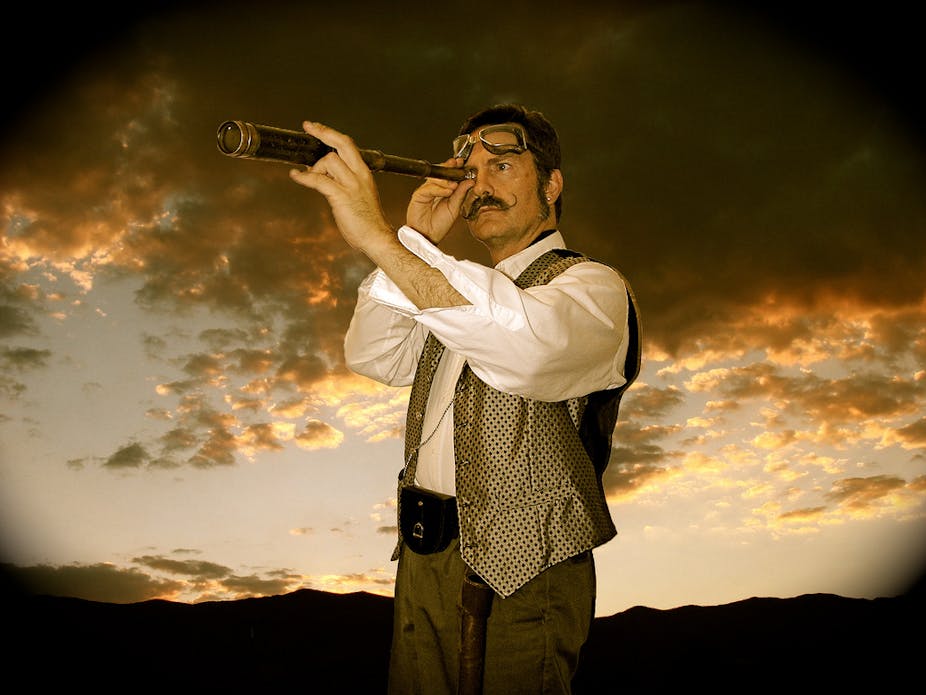Last week, scientists set a new distance record, seeing a burst of gamma-rays from a star that exploded when the universe was only 520 million years old. The light from this distant source has been travelling for 13.14 billion years – more than 95% of the age of the universe.
Light travels blisteringly fast, covering almost 300,000 km every second. But this speed is finite, meaning that the world we observe is not as it is now, but as it was when the light began its journey.
For watching the television, we can safely ignore the tiny light travel-time from the screen to your eye. Moving out into the cosmos we cannot neglect it; in fact, we can use it to our advantage.
Travelling light
The moon we see is as it was a little over a second ago, while the light from the sun takes eight minutes to travel from the solar surface to Earth. On truly cosmic scales, the light travel-times become immense, taking more than 2 million years to cover the distance from the nearest galaxy, Andromeda, to our own.
This means the further we look, the further back in time we see, and the entire history of the universe is laid out on a canvas for us to observe. In fact, seeing the early epochs of the universe, catching stars and galaxies in their initial moments of formation, has greatly expanded our knowledge of the workings of the cosmos.
In recent years, the media has been abuzz with the discovery of the most distant objects – be they new star-forming galaxies or intense bursts from collapsing super-stars – whose light set out only half a billion years after the Big Bang and has taken over 13 billion years to reach us.
Given this, we might ask if, with a little more telescope effort, we can bridge this last half a billion years, and see the Big Bang itself.
The truth is, however, that we have seen back in time as far as we ever will, and we reached this observational limit in the mid-1960s.
To understand this, we have to look at the history of the cosmos.
Hot stuff
Born in the Big Bang 13.7 billion years ago, the universe was initially extremely hot and dense.
In this state, it was a sea of electrons, protons and light rays flying around and vigorously bouncing off one another, effectively like a fog through which light cannot freely travel.
The universe remained this way until it was 250,000 years old, by which time it had expanded and cooled to the point where electrons and protons could join to form the first hydrogen atoms. As a result, lights rays were free to travel unhindered through a now-transparent universe.
How does this affect the way we observe the universe?
Imagine you are standing in a thick fog. Light from a nearby flower, only metres away, sets out from a petal, but quickly strikes a water droplet and bounces off in a random direction, and then another and then another. The result is that light from the petals, and the grass, trees and every other object is scrambled together, so all our eyes see is a grey, featureless wall of fog.
What if the fog suddenly lifts, and light rays can travel freely? The garden is revealed, but if it is large enough we will need to worry about the time it takes time to travel to our eye. The nearest flowers appear first out of the fog, and then the more distant trees.
But some rays that were bouncing around in the fog now can stream into our eyes, and the garden is revealed within an expanding wall of fog, a grey wall of the last scattering, receding from us at the speed of light. We can see no further.
At the limit
This is what happens in the universe, and it is the light emerging from the high density fog of the early stages that sets the limit on how far back we can see. That is, we cannot see earlier than 250,000 years after the Big Bang.
This light – the wavelength of which has been stretched and cooled by factors such as universal expansion – now bathes Earth as the Cosmic Microwave Background.
This radiation was discovered in the 1960s, and is now the target of ongoing and future experiments such as WMAP and Planck.
While the light we detect in the Cosmic Microwave Background has been traveling for 13.5 billion years, the atoms from where it was emitted were separated from the atoms that eventually formed us by only 40 million light years. But since emission, the universal expansion has greatly increased, and the stars and planets those atoms became are now more than 46 billion light years away.
An attentive reader may now be asking how we know so much about the very early universe – the initial seconds and minutes in which the basic elements were cooked – when this period is shrouded in the fog that existed. While we cannot see these early epochs, the laws of physics still apply and we can use them to infer the unseen.
But in winding the cosmic clock backwards the density and temperature of the universe reach a point where our laws of gravity and other forces, as we presently know them, can no longer work.
Without a revolution in physics, the very birth of our universe will remain forever hidden from us.
Are you a researcher or academic working in astronomy? Would you like to contribute to The Conversation? Email pitch@theconversation.edu.au

